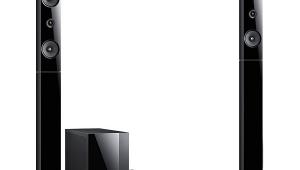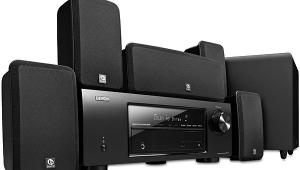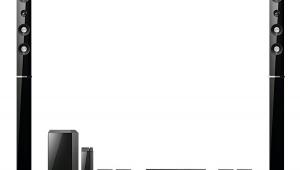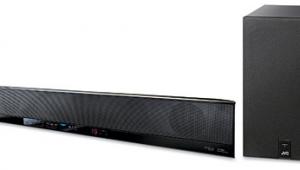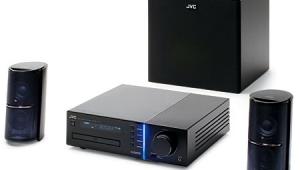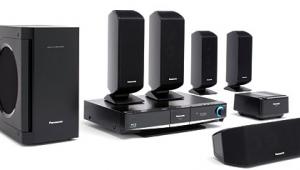Sharp SD-SP10 HTIB
My office—cubicle, actually—is in Manhattan, so I get it: Despite your love of movies and music, some readers either don't want or just can't deal with a full array of five loudspeakers plus a subwoofer. Rather than settle for simple stereo (and I mean no disrespect to John Atkinson and his Stereophile crew down the hall), some overachieving sub/sat systems add often proprietary processing techniques to simulate sprawling surround sound. But what if newly released signal-processing algorithms offered so much control over the listening experience that they could turn a budget home-theater-in-a-box into a sound lab of sorts, allowing you to experiment with a previously impossible milieu of realistic audio illusions?

Let the Audistry Begin
Sharp's easily affordable SD-SP10 home theater audio solution is the first consumer electronics product that offers the Audistry suite of new sonic features. The Audistry moniker comes from the Australian company that spent three years developing the technologies before Dolby acquired them. Essentially answering the "What's next?" question, the goal of Audistry is to make audio more personal—that is, more specific to the individual listener. Two people might like the same band, but one might prefer the rocking bass, while the other might prefer the vocals. The various settings allow the user to easily tailor the details of the music or movie to suit his or her distinct, personal tastes. Audistry's Natural Bass strives to give smaller speakers the impact of larger ones. The Intelligent Volume Control serves as an automatic expander and limiter, and the Mono to Stereo Creator does exactly what the name implies. Further, you can combine these tweaks to customize tunes and soundtracks to best fit your taste.
With the SD-SP10, Sharp combines the Audistry package with their high-resolution 1-Bit audio technology. This technology samples audio signals 28 times faster than a CD for more accurate reproduction of complex material. Also on board are the Dolby Virtual Speaker enhancement and Dolby Pro Logic II processing, as well as Dolby Digital and DTS decoding. These are all located inside the single main speaker's housing, along with the three-channel power amplifier. The squat, hefty, fan-cooled main unit can sit above or below your display, and it sports a pair of flip-out feet, should you wish to further direct the sound. Bare-wire cable connects it to the tall, narrow, front-ported/side-firing subwoofer. The sub has a stand for added steadiness, and it's removable.
The Audistry technology is remarkably simple to use. It drops the technical obstacles that might scare away the timid and provides results you can really hear—and will likely enjoy. The remote offers four neatly clustered direct-access keys to turn on or off the individual Audistry effects. You'll quickly recognize the tiny green lights behind the metal mesh grille on the face of the speaker as confirmation that each effect is active. I can't help but think that, someday, a midlevel or high-end Audistry-enabled product might offer some specific LED or LCD readout of the system status, either on the face of the subwoofer or the main speaker or perhaps on the remote.
You can feed the raw digital signal from a DVD player directly to the SD-SP10 via multiple digital inputs. Here, the signal will meet with true Dolby Digital or DTS processing and then go out to the two woofer/tweeter combos and the sub. However, since Audistry reportedly works wonders with lesser-quality audio, I found the potential sonic stylings from the analog inputs to be far more intriguing.
 Super-Size My Mono to Stereo, and Hold the Bass
Super-Size My Mono to Stereo, and Hold the Bass
You can completely enable or disable each effect, or you can adjust the soundfield's width and overall space using the Sound Space Expander, the most dramatic of the Audistry features. It renders the impression of three additional—virtual—speakers: a very stable center channel, plus two surrounds. This trick, like all of the rest of Audistry's repertoire, is nonintrusive and doesn't compromise the vocals or the perceived headroom in any way. There's no apparent change in EQ levels or tonal balance, and the volume remains nearly unchanged. The implementation is seamless. You can switch it on and off while a song is playing, and the transition, while audible, is not jarring. After a few minutes with movie and music clips—each with various configurations of the Audistry enhancement—I preferred these versions to the unmodified originals. That's precisely what Dolby is striving for. Could it be that they want us to use this technology all the time, and then, once we're hooked, the price will go up? Or am I just being paranoid? Audistry also offers technology to enhance the headphone experience, although the SD-SP10 does not support headphones.
Not every imaginable combination of effects is possible, however. If you turn on the Sound Space Expander, for example, the SD-SP10 deactivates Virtual Speaker and Pro Logic II. There are many other permutations, though. There are five one-touch Sound Mode presets—Late, Standard, Announcer Sound, Cinema, and Sports. These modes automatically configure Dolby Virtual Speaker and the four Audistry functions to predetermined positions. With big-budget Hollywood movie soundtracks, the SD-SP10 can definitely play loudly. Its unique audio presentation ably fills a medium-sized home theater from front to back and side to side. The most striking thing, however, is the before-and-after difference in low-bit-rate MP3 music files. The SD-SP10 gives the illusion of replacing the dynamic range and the separation of instruments not heard since the files began their lives as full CD tracks. There's a satisfying fullness and clarity that they might not have even had way back then. Working with older music, or the soundtrack to almost any Woody Allen film, the Mono to Stereo Creator organically brings one-channel music into the future—or at least into the present—without ever being conspicuous.
Directional 5.1 effects such as those featured in The Patriot were not truly discrete. But this new rendition created its own credible phasing of the whizzing gunshots, and nuances such as tweeting birds in the distance were practically there on the sofa beside me. My only real criticism of the system's performance is minor. When you crank up the sub and speakers during big, complex action scenes on killer discs like Master and Commander, there is a faint hollowness, particularly in the sub. In fact, I wouldn't ask the supplied subwoofer to do too much heavy lifting. Fortunately, though, Sharp supplies a sub pre-out jack, should you wish to upgrade your low-end performance. Still, in more common use—at 80-percent volume or less—and with so many ways to fine-tune the sound, the Audistry-enabled Sharp SD-SP10 is a very capable, extremely versatile audio option.
Highlights
• Complete 2.1 audio solution: speakers, amp, and processor
• Wonderful Audistry enhancement, plus Dolby Digital and DTS
• Simple hookup and operation
- Log in or register to post comments
